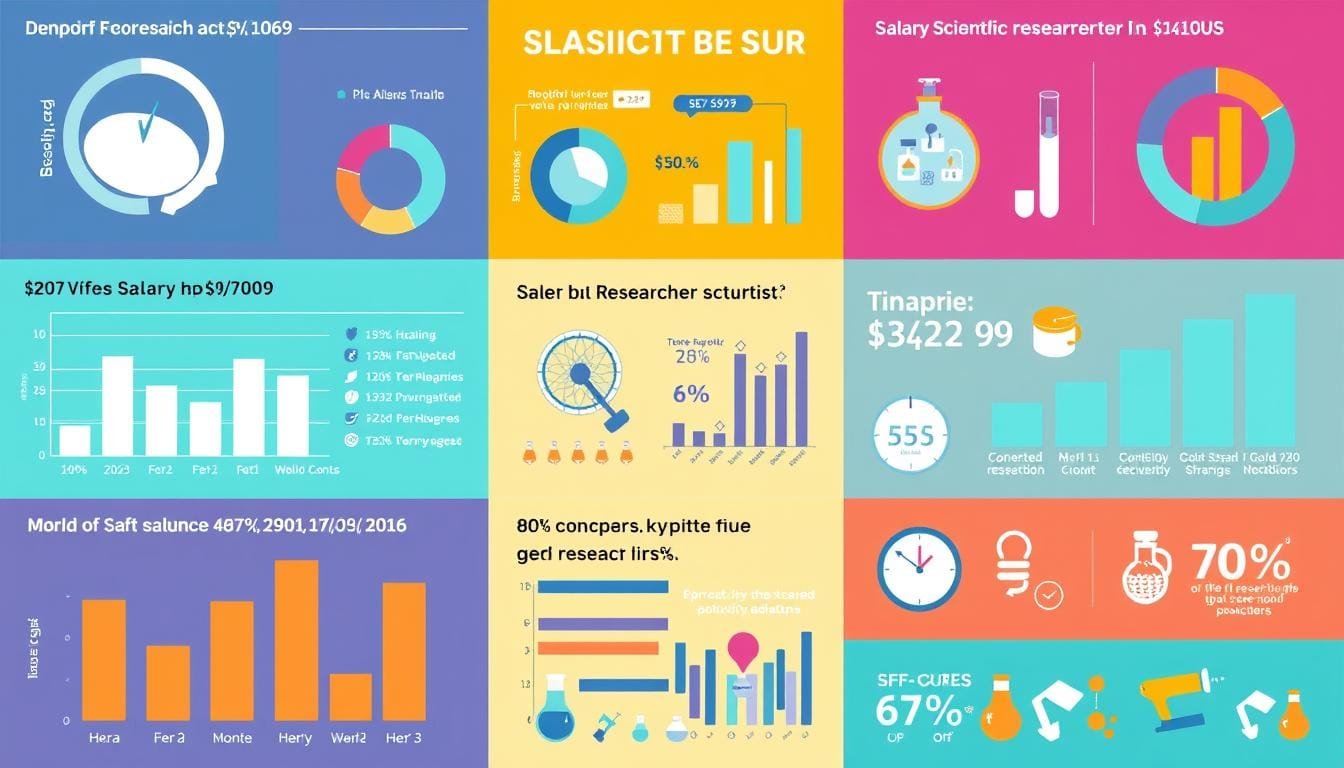Looking into how much scientific researchers make shows a clear line between working in schools vs. companies. The journey through career earnings for researchers highlights how different these worlds can be. It tells a story of choosing between the chase for knowledge or the drive for more money.
The way money comes into play in scientific research is complex. It changes based on where you are, how much you know, and what you do. Interestingly, pay for postdocs in schools just went up to $70,000, showing a big change1. However, moving over to the business side often means making much more money. This is because businesses really value your deep knowledge, especially in growing areas like science. A great example is Ilya Sutskever from OpenAI. His work in AI nets him a huge salary, showing the high value of such roles2.
Key Takeaways:
- A shift towards higher starting salaries for postdocs in academia up to $70,0001.
- The allure of industry roles as evidenced by significant careers like Ilya Sutskever, OpenAI’s Chief Scientist2.
- The critical balance of salary potential against the intrinsic value of academic pursuits
- An exploration of the impact of specialization, geography, and experience on scientific researcher income
- Insights into changing perceptions and the sustained growth of the scientific industry3
Introduction to Scientific Researcher Careers
Exploring scientific research roles starts with knowing the many chances and duties they bring. Scientists do important work like running complex research and writing papers. They help knowledge grow in areas such as biology, chemistry, and computer science.
Understanding the Role of a Scientific Researcher
Scientific researchers play a key role in growing our understanding of science and tech. Staff Scientist roles in labs may be for a set time or sometimes lead to a steady job4. They spend their days doing careful tests, analyzing data, and sharing what they find.
Different Paths: Academia vs. Industry
The career path comparison between academia and industry shows big differences. Academia focuses on basic ideas and deep knowledge. Industry jobs, like those for Computer and Information Research Scientists, work on real-world applications and usually need a master’s degree or more5.
For those looking at an industry research job, roles like Computer Scientists need lots of learning and training5. It’s a tough but rewarding path. Getting ready for these jobs means being able to manage big projects and new ideas that big companies look for.
| Position Title | Required Qualification | Typical Employment Type |
|---|---|---|
| Staff Scientist | Doctorate/Professional Degree | Renewable/Fixed Terms |
| Computer and Information Research Scientist | Master’s Degree | Full-Time |
| Senior Associate Scientist | Advanced Degree with Research Experience | Permanent/Promotion-Based |
Choosing an academic research career or an industry job shapes the work you do and your innovation and income chances. Both options offer great experiences but require careful thinking about your long-term career goals and what you want in scientific research.
The Transition from Academia to Industry: Why Make the Move?
Researchers often switch from academia to industry for better pay and growth chances. BioSpace 2020’s report shows men make $82,516 in academia but $144,181 in industry. For women, it’s $58,966 versus $129,480 in industry6. This big pay gap showcases the financial benefit of such a move.

Industry jobs also promise quicker research and development. This means projects get to market faster. Scientists get to see their work make a real-world difference6. This appeals to those wanting their research to have direct applications.
Moving to industry helps scientists grow professionally. In industry, success comes from market results like sales, not just publication counts6. Learning business skills alongside science is key.
| Parameter | Academia | Industry |
|---|---|---|
| Average Salary (Men) | $82,516 | $144,181 |
| Average Salary (Women) | $58,966 | $129,480 |
| Project Life Cycle | Long-term Research Focus | Quick Commercialization |
| Success Metrics | Publications & Citations | Market Impact & Revenue |
In an industrial setting, clear career progression paths exist. This is less so in academia6. The switch also opens up new networks and access to top tech.
Choosing to move into industry should align with a scientist’s career goals. Faster development and wanting to make a bigger impact guide this choice. Understanding these factors and seeking necessary skills is essential.
Exploring the Salary Gap: Academia vs. Industry
When we talk about salary differences in research, we notice a big split between academia and industry. This gap shows us how different career paths pay. It also tells us a lot about choosing a career in science.
What the BioSpace 2020 U.S. Life Sciences Salary Report Reveals
The BioSpace 2020 U.S. Life Sciences Salary Report shows a clear earnings gap. Only 5% of those in academia make over $150,000. Compared to this, 17% of industry professionals hit this mark7. The top salaries, from $110,000 to more than $200,000, are twice as common in industry7. These numbers reveal a real difference in pay that can affect where scientists choose to work.
Impact of Gender on Salaries in Science
The gap in pay between genders in science is still a big problem. It gets worse with the differences in pay between sectors. The salary report shows this issue but also points out how hard it is for women to get high salaries in either field. This makes the pay gap even bigger and can change how happy and how long women stay in their science careers.
For new and seasoned scientists, it’s vital to think about these pay differences. Knowing about the pay in different areas can help you make better career choices.

The academic vs. industry and gender pay gaps in science shape careers and have wider impacts. Addressing these gaps helps move toward fairer pay in science.
How Much Money Do Scientific Researchers Make
Learning about the average research scientist salary and earnings in STEM fields is crucial. These can change a lot due to factors like specialization, experience, and where you live. The salaries of scientists show a complex picture of money matters in these areas.
As of May 2021, medical scientists made a median yearly wage of $95,310. This number changes based on sector and location8. The top paying sector was research and development in sciences, with a median salary of $102,2108. Meanwhile, those in hospitals and physician offices earned around $79,800 and $79,760, respectively8.
There are big differences in what biomedical scientists earn across different states. New Jersey and Connecticut had the highest salaries for scientists8.
- The job outlook for medical scientists shows a strong growth of 17% by 2031. This suggests great career opportunities and potential for higher earnings in this field8.
- Groups like The International Association of Biomedical Sciences (IABS) and The Institute of Biomedical Science (IBMS) offer great networking and support. This can help with career advancement and salary increases8.
Looking at academia, there’s been a significant increase in academic research scientists. Their numbers rose by 150% from 2000 to 20129. Here, progress and pay often depend more on time in the system and publications than on direct performance9.
In short, many factors impact the average research scientist salary and income potential in STEM. Both the industry and academia offer different financial outcomes. This highlights the need to understand the wide-ranging salary statistics for scientists when making career choices.
Factors Influencing Scientific Researcher Salaries
Scientific researchers’ pay varies widely. It depends on their specialization, where they work, and their experience. These factors come together, shaping salaries in the research world.
Role of Specialization and Field of Study
What researchers focus on greatly affects their earnings. Cutting-edge or commercially valuable fields offer better pay to draw in experts. For example, people in biotechnology, pharmaceuticals, and AI usually earn more than those in ecology or zoology. A salary survey shows commercial scientists earn about 30% more than academic ones10. This points out the difference in pay based on specialization10.
Geographic Location and Its Impact on Salaries
Where researchers work matters a lot for their salaries. For instance, those in Geneva, Switzerland, earn between $119,710 and $153,090. This is much higher than Cairo, Egypt, where they make $6,990 to $25,63111. Even within the same country, like India, pay can vary significantly. In New Delhi, salaries range from $9,604 to $24,070, above the national average11.
Experience Level: Entry-Level vs. Senior Positions
Pay increases with experience in the research industry. Beginners, especially data scientists, might start at $117,276. But seasoned experts can reach up to $190,00011. This difference shows how valuable experience is and the financial growth possible over time11.
| Position | Starting Salary | Mid-Career Salary | Senior-Level Salary |
|---|---|---|---|
| Entry-Level Researcher | $117,276 | $153,465 | $190,000 |
| Data Science Manager | $186,770 | $206,770 | $226,770 |
The world of scientific research careers is complex. It’s shaped by what you specialize in, where you work, and your experience. Understanding these factors is key for those making their way in this field.
Navigating Career Progression for Higher Salaries
Advancing a career in science means focusing on skills development and smart moves across the industry. Recognizing steps for salary growth across sectors can boost a scientist’s career big time.
Importance of Continuous Learning and Skill Enhancement
Today’s fast-paced science world demands ongoing learning. Scientists who add new skills, especially in new tech, can climb up their career ladders more easily. For instance, Clinical Research Coordinators (CRCs) who learn more about regulations can become Clinical Research Associates (CRAs). This change can raise their salaries from $50,000 to as much as $100,000 in a few years12.
Also, beginner data scientists with strong statistical and analysis skills can quickly move to senior roles. Their pay can jump from $70,000 to about $137,000, showing the high demand for their expertise13.
Transitioning Between Sectors for Salary Gains
Moving between academic research and industry roles can greatly increase what you earn. Switching from an academic postdoc with pay around $37,740 to a Patent Agent in the intellectual property sector can more than double a salary to about $98,08014.
Moreover, Data Scientists who shift into specialized roles like Analytics Managers can see their salaries skyrocket. They might earn up to $296,00013.
Exploring different sectors can grow your skills and significantly boost your salary. It highlights the need for adaptability and ongoing professional growth in today’s ever-changing economy.
By valuing continuous learning and making smooth sector transitions, science professionals can massively increase their earnings. They can also ensure strong career growth in the scientific field.
Real-World Salary Insights: Case Study of Nvidia
In exploring tech industry salaries, we look closely at Nvidia. This case study shows us how companies reward experience and skill in specific roles. By looking into Nvidia salary insights, we understand how salaries change with role and experience in tech.
Understanding the Salary Ranges in the Tech Industry
The tech world is known for its high salaries, and Nvidia leads the way. They pay well for jobs crucial to their success and growth. Nvidia’s salaries show the high value they put on unique knowledge and skills1516.
How Experience and Role Determine Pay at Nvidia
At Nvidia, pay varies greatly between roles like data scientists, engineers, and developers. This shows the strong role-experience salary correlation. Top engineering jobs at Nvidia can offer up to $300k, with stock options adding more15. Nvidia uses this strategy to keep the best talent.
The kind of work and responsibilities in tech roles at Nvidia decide the pay. Skills in new tech like machine learning are key, as Nvidia focuses a lot on these areas17.
| Position | Average Salary | Key Skills Required |
|---|---|---|
| Data Scientist | $300K | Python, Statistics, Machine Learning |
| Senior Engineer | $300K+ | System Architecture, Leadership |
| Machine Learning Engineer | $250K | Deep Learning Frameworks, GPU-Accelerated Computing |
The salary data underscores the tech world’s competitive nature. It shows that strong technical and people skills lead to better pay packages17.
Nvidia stands out in how it sets salary standards. It shows a clear link between role, experience, and their value to the company1516.
Conclusion
We took a deep dive into the world of scientific research careers. We looked at how these careers are growing and the factors that affect future salaries. It’s clear, seeing Reed-Elsevier’s profit margins, that working in science can be rewarding in many ways. These areas include both intellectual satisfaction and the potential to earn well18.
The fact that private companies fund most U.S. clinical trials raises questions. It makes us think about the impact this might have on research impartiality. But, there are measures in place to lessen this risk. This requires us to challenge what’s considered normal to protect the science’s credibility19. High-impact institutions like SAO, SERC, and STRI show the scope for being part of important research projects20.
Being a research scientist offers not just good pay, but also a chance to truly contribute to the STEM areas. This career is attractive because of the job growth, the ability to switch between fields, and the joy found in learning and improving one’s skills. The insights shared here guide those at a turning point in their career choices.
FAQ
What factors contribute to the income potential of a scientific researcher?
The income potential of a scientific researcher depends on many things. This includes their field, whether they work in industry or academia, and where they’re located. Gender, how much experience they have, and access to resources and technology matter too. Advancing in their career and learning new things can also help them earn more.
How do career earnings for academic researchers compare to those in industry?
Researchers working in the industry usually make more money than those in academia. Reports, such as the BioSpace 2020 U.S. Life Sciences Salary Report, back this up. This big difference in pay is why many researchers move from academia to the industry.
Why might a scientific researcher transition from academia to industry?
Researchers might move to industry for better pay and the chance to work on projects that make a real-world impact. They’re drawn by the promise of being rewarded for their achievements. Plus, industry jobs can offer faster career and salary growth.
Does gender impact the salaries of scientific researchers?
Yes, there’s a pay gap between men and women in science, seen in both academia and industry. This issue is part of the bigger challenge of income and fairness in science careers.
What is the average salary of a research scientist in the United States?
The average salary for a research scientist in the U.S. varies a lot. This is based on many factors. For example, it depends on their experience level and if they specialize in areas like biology, chemistry, or computer science.
How does one’s field of study impact their salary as a scientific researcher?
Being specialized in a growing and in-demand field can lead to higher salaries for researchers. For example, experts in new areas like biotechnology or artificial intelligence might earn more than those in established fields.
Can a scientific researcher’s geographical location affect their salary?
Yes, where a researcher works hugely affects their pay. Salaries can be higher in places with a high living cost. Also, pay rates vary around the world, showing how location impacts salary.
What role does experience play in the salary of a scientific researcher?
Experience greatly influences a researcher’s salary. There’s a clear difference in pay based on how much experience one has. A deeper experience level boosts negotiating power and the chance to land higher-paying, senior roles.
How can a scientific researcher advance their career and increase their salary?
A scientific researcher can grow their career and salary by never stopping learning. They should improve their skills and keep up with new developments in their sector. Moving between academia and industry can also open up more chances for making more money.
What insights can be gained from Nvidia’s disclosed salary data for research-related roles?
Nvidia has shared salary data for jobs like research scientists and engineers. It shows salaries can widely differ. Factors such as experience, the job role, and how one’s skills match the company’s goals affect pay ranges.
